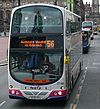
Baldernock meaning 'settlement of St Earnaig' is a small parish in East Dunbartonshire, Scotland, ten miles (16 km) to the north of Glasgow's city centre.
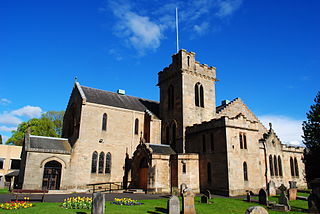
New Kilpatrick, is an ecclesiastical Parish and former Civil Parish in Dunbartonshire. It was formed in 1649 from the eastern half of the parish of Kilpatrick, the western half forming Old Kilpatrick. New Kilpatrick is also a disused name for the town of Bearsden.

Ramsbottom railway station is a heritage station serving the town of Ramsbottom in Greater Manchester, England.

Kilnhurst Central was a railway station in Kilnhurst, South Yorkshire, England, one of two railway stations serving the village, the other being Kilnhurst West, situated on the North Midland Railway line. Kilnhurst Central was on the former Great Central Railway's (GCR) Sheffield Victoria - Doncaster line, between Parkgate and Aldwarke and Swinton Central.
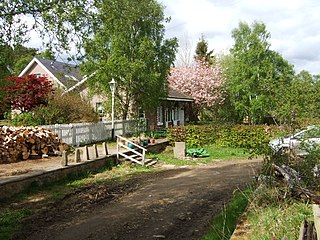
Dess railway station was opened on 2 December 1859 on the Deeside Extension Railway and served the rural area around Dess House and estate from 1859 to 1966 as an intermediate station on the Deeside Railway that ran from Aberdeen (Joint) to Ballater.

Arkwright Town railway station was in Arkwright Town, Derbyshire, England.
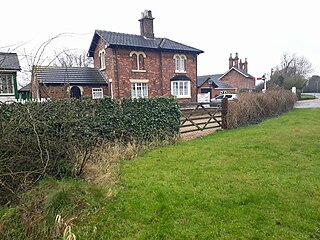
Legbourne Road was a railway station on the East Lincolnshire Railway which served the village of Legbourne in Lincolnshire between 1848 and 1964. The station was closed to passengers in 1953, and withdrawal of goods facilities took place in 1964. The line through the station closed in 1970. The station once housed a museum containing railway memorabilia; this closed in 1998 and the building is once again a private residence.
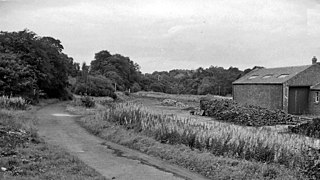
Balerno railway station was opened in 1874 and served the area of the village of Balerno that now forms part of the city of Edinburgh. Although primarily built as a goods line, with a dedicated goods station at Balerno, serving the many mills on the Water of Leith, a passenger service was provided by the Caledonian Railway using the Balerno Loop and after grouping by the London, Midland and Scottish Railway, seeing formal closure to passenger traffic shortly after nationalisation. The station was the only one with a separately served goods station on the 'loop' line and lay in rural surroundings that had been popular with families having a day out in the country.
Witney goods station served the Oxfordshire town of Witney on the Oxford, Witney and Fairford Railway. It consisted of seven sidings, a goods shed, a wooden parcel office and a cattle dock. It also had an engine shed, which was demolished early in the twentieth century. Following the opening of the East Gloucestershire Railway in 1873, the station became a goods depot, with passengers using the second station situated to the south. The original station remained open to goods traffic until 1970.

Flecknoe was a railway station that served the village of Flecknoe in Warwickshire, England, on the Weedon to Leamington Spa branch line. The station was built in a remote location in open countryside around 1.5 miles north-west of Flecknoe, it also served the small nearby hamlets of Sawbridge and Lower Shuckburgh, both within a couple of miles of the station.

Broomhill railway station or Broomhill for Nethy Bridge railway station is a reconstructed railway station on the former Highland Railway main line which was originally built to serve the small villages of Nethy Bridge and Dulnain Bridge in Strathspey. It is at present the eastern terminus of the Strathspey Steam Railway.
The Kelvin Valley Railway was an independent railway designed to connect Kilsyth, an important mining town in central Scotland, with the railway network. It connected Kilsyth to Kirkintilloch and thence over other railways to the ironworks of Coatbridge, and to Maryhill, connecting onwards to the Queen's Dock at Stobcross.

Brafferton railway station served Brafferton, North Yorkshire, England, from 1847 to 1964 on the Pilmoor, Boroughbridge and Knaresborough Railway.

Milltimber railway station served the Milltimber area within the parish of Peterculter from 1854 to 1937 on the Deeside Railway that ran from Aberdeen (Joint) to Ballater. This area at that time had a number of mansion houses, estates, etc. such as Culter House, Fairgirth House, Camphill House, Avondow House, Glasterberry House, etc. whose workers, etc. would have used the station. Milltimber was only a short distance from Murtle station. The station was named for the nearby Milltimber Farm.

Juniper Green railway station was opened in 1874 and served the area of the then village of Juniper Green that now forms part of the city of Edinburgh. Although primarily built as a goods line to serve the many mills on the Water of Leith, a passenger service was provided by the Caledonian Railway using the Balerno Loop and after grouping by the London, Midland and Scottish Railway, seeing formal closure to passenger traffic shortly after nationalisation. The station lay in rural surroundings despite being only a short distance from the centre of Edinburgh and had been popular with families having a day out in the country.

Torrance railway station was opened in 1879 on the Kelvin Valley Railway and served the area of the village of Torrance in East Dunbartonshire until 1951 for passengers and 1959 for freight.

Balmore railway station was opened in 1879 on the Kelvin Valley Railway and served the coal mining area, farms and the village of Balmore in East Dunbartonshire until 1951 for passengers and to freight on 31/7/61.
Twechar railway station was opened in 1878 as Gavell on the Kelvin Valley Railway and renamed Twechar in 1924. The station served the hamlet of Twechar and the coal mining area, Gavell House and Farm, etc. in East Dunbartonshire until 1951 for passenger travel. and to coal traffic to the Cadder Yard until 1966.
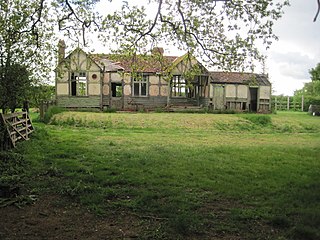
Thorganby railway station served the village of Thorganby, North Yorkshire, England from 1912 to 1964 on the Derwent Valley Light Railway. The station had services northwards to York and south to Cliffe Common, which was a station on the line between Selby and Market Weighton.
Wath-in-Nidderdale railway station, was one of two intermediate stations on the Nidd Valley Light Railway, in Wath-in-Nidderdale, Yorkshire, England. The station was opened in September 1907, and closed to passengers in January 1930, however the line remained open until 1936 to transport freight to and from the reservoirs in the Upper Nidd Valley.


















